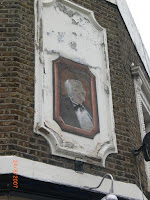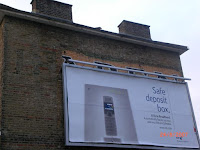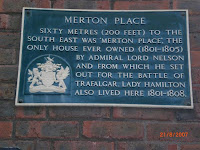Kingston Road runs along the southern edge of Wimbledon up to its border with the leafy environs of Merton Park. There’s an air of civic virtue in the buildings compared to those going the other way toward Tooting – Masonic lodges, Salvation Army, Clubs, St. Johns Ambulance, colleges and council buildings all to be found within a few hundred yards of each other. There are still roads full of small Victorian and Edwardian cottages to the north and still lots to be seen above the frontage but this is definitely a road of plaques and inscriptions.
1) Starting off from Pincott Road I noticed a pub sign that I’d missed before. Although now ‘The Kilkenny Tavern’ it seems it was previously known as ‘The Dark House’, which has to be one of the least uplifting pub-names ever!
2) Crossing over by South Wimbledon tube and we are in Kingston Road proper
3)There’s a fine building down on the left hand side with a neat metal sign over the entrance. Now known just as ‘The Manor Club’ it now hosts concerts and is hired out for functions. 
The interesting thing on this plaque is not so much the fact that it opened in 1890, but that the president of the club was John Innes esq. He of the horticultural fame who is probably best known as founding The John Innes Institute and having a range of potting compost named after him. I don’t know much about the club's history or original purpose although as John Innes was Lord of the Manor of Merton it might be named 'The Manor Club' a bit of self-aggrandizement!
4)Slightly further down the road is the Merton Masonic Lodge with another intriguing inscription. ‘Be Traist’ doesn’t seem to be a specific Masonic motto but a bit of searching on the internet reveals that it means ‘Be Faithful’ and, (surprise, surprise) just happens to be the motto of the Clan Innes! What are the chances of John Innes also being the first Grand Master of the Lodge? I’m not sure about the crest though although I suppose there’s a good chance that it’s his as well…
5) No longer used by the council these offices are elegant and again part of the development of the area at the turn of the century.
6)Just a few feet down is a building definitely not from the turn of the century but still dedicated to the public good. The slightly battered emblem from the St John Ambulance yard.

8)I crossed over at the tram line at Hartfield Road to take a look at one of my favourite local buildings, now boarded up. It is the shape of a very thin slice of cake and used to go by the name of ‘Ju-Ju Dinner Jackets Café’. A real exercise in squeezing the maximum of space out of a site!
9) Heading back to South Wimbledon on the other side of the road I spotted this on the wall above a Chinese take away. A good luck sign maybe?
10) Checking the dates it's apparent that this old street sign hasn’t been touched since at least 1965 when the Borough of Wimbledon was abolished.
11) One of a row of about six of these ‘Improved Patent Safety Plate’ coal-hole covers in front of a row of shops.
13) You can't miss this this slightly naïve and odd looking bit of wall art on the corner of Palmerston Road. From the ornate quality of the windows and general layout I believe it was originally a pub called the Lord Palmerston. In fact I’m pretty sure I remember it operating as such about five years ago.
14) The last plaque of the walk belongs to the Salvation Army and is a bit boring to be truthful. It’s too high to have a look at what seems to be quite an ornate pattern and it looks as though it’s been stuck on as a bit of an afterthought.
15) Back near Pincott Road again and my eye was caught by this lively but crumbling bit of tiling above a motorcycle shop. I couldn’t think what the building might originally have housed and the only thing I could tie in with its rakish demeanour was something like a billiard hall, although it’s probably a bit on the small side. Any ideas?




















































